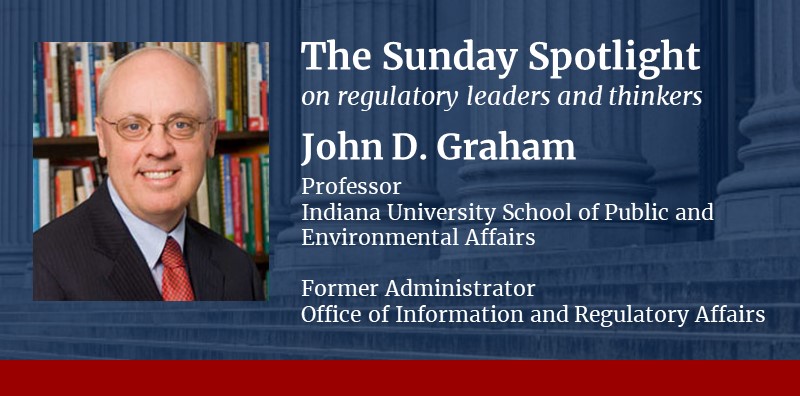
John D. Graham discusses reforming the regulatory process to prioritize equity.
In a discussion with The Regulatory Review, regulatory policy expert John D. Graham emphasizes the need for greater consideration of equity in regulatory reform efforts.
Equity concerns have received renewed attention since President Joseph R. Biden signed an executive order to advance “racial equity and support for underserved communities” in January 2021. In an earlier essay in The Regulatory Review, Professor Graham described the importance of protecting the poor in regulatory decisions by using equity-focused benefit-cost analysis to evaluate new agency rules.
Graham also emphasizes the need for additional data collection to reveal how regulations impact low-income individuals. In recent years, many researchers and organizations, such as the Organization for Economic Cooperation and Development, have emphasized the importance of gathering and disclosing robust data about people who will be most affected by regulations.
Graham is currently a professor and former dean at the Paul H. O’Neill School of Public and Environmental Affairs at Indiana University. From 2001 until 2006, he served as the Administrator of the Office of Information and Regulatory Affairs (OIRA) within the U.S. Office of Management and Budget. During his time as OIRA Administrator, Graham oversaw the regulatory, information, and statistical activities of the federal government. He encouraged smarter decision-making about regulations, promoting regulatory analysis that sought to lower regulatory costs but also that prompted new regulations with substantial benefits.
Graham is a leading scholar of public policy and public administration. From 2006 to 2008, he served as dean of the Frederick Pardee RAND Graduate School at the RAND Corporation—the world’s largest doctoral program in policy analysis. In July 2008, Graham was appointed as dean of the O’Neill School of Public and Environmental Affairs at Indiana University. He is currently a Professor at the O’Neill School and focuses his attention on government reform and energy and environmental regulation.
The Regulatory Review is pleased to share the following interview with Professor John Graham.
TRR: What do you think are the most important types of regulatory reforms needed in the United States today?
Graham: The weakest functioning branch in the federal regulatory system is the U.S. Congress. The bitter and evenly balanced partisanship has made it very difficult for Congress to pass any form of needed reform legislation, whether it be pro-regulatory, deregulatory, or even a simple evidence-based change in the rulemaking process. A good starting point for Congress would be to create a congressional regulatory analysis office modeled after the Congressional Budget Office.
TRR: President Biden signed an executive order on “modernizing regulatory review” the day he took office. How exactly should regulatory agencies consider the “distributional consequences of regulations,” as mandated in the executive order?
Graham: As a starting point, the Biden Administration should analyze the impacts of regulation on low-income individuals. If a regulatory proposal creates more harm than good for low-income people, then it should be reconsidered, even if it creates net benefits for the average person. Equity means taking care to consider the impacts of policy choices on individuals who are least well off.
TRR: Can you provide an example where agencies have done an especially good job of factoring equity into regulatory decisions?
Graham: I have never seen a good equity analysis in a regulatory impact assessment.
TRR: Many people argue against stringent regulation because it makes goods and services more expensive over time—the impacts of which will fall more heavily on individuals with lower incomes. If regulators give special attention to the well-being of the worst-off citizens, does this mean that regulators should impose less stringent or protective regulations, at least in some cases? If so, when?
Graham: As part of equity analysis, regulators should examine carefully all rules that would raise the prices of necessities such as food, clothing, gasoline, electricity, water, and housing. Protecting low-income individuals might lead to less stringent or less protective regulations in some cases, but in other cases it might cause redesign of regulations to maximize benefits and minimize costs for low-income people. Or the federal government can supplement regulations with subsidies for low-income communities, as is now happening with drinking water systems.
TRR: If OIRA today mandated every regulatory agency to implement the equity test and social efficiency test that you have previously described, what do you think agencies would struggle with the most in implementing such a mandate?
Graham: Many federal agencies are not currently collecting data on how their regulations impact low-income individuals. Those agencies need to secure OMB approval to collect equity-oriented data. A good example is the National Highway Traffic Safety Administration’s (NHTSA) effort to save lives in car crashes. NHTSA’s Fatal Accident Reporting System does not even collect information on the income profiles of Americans who survive or die in car crashes.
TRR: Over the course of your career, what innovations in regulation have you come across that you think deserve more attention?
Graham: The biggest process innovation of the last 50 years was the creation of OIRA. The office has been used effectively by each President since Ronald Reagan. It is heartening that the U.S. Senate finally confirmed, at the very end of last year, President Biden’s nomination of a well-qualified person to run OIRA in his Administration. Better late than never!
The Sunday Spotlight is a recurring feature of The Regulatory Review that periodically shares conversations with leaders and thinkers in the field of regulation and, in doing so, shines a light on important regulatory topics and ideas.



